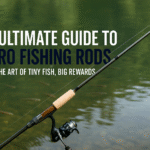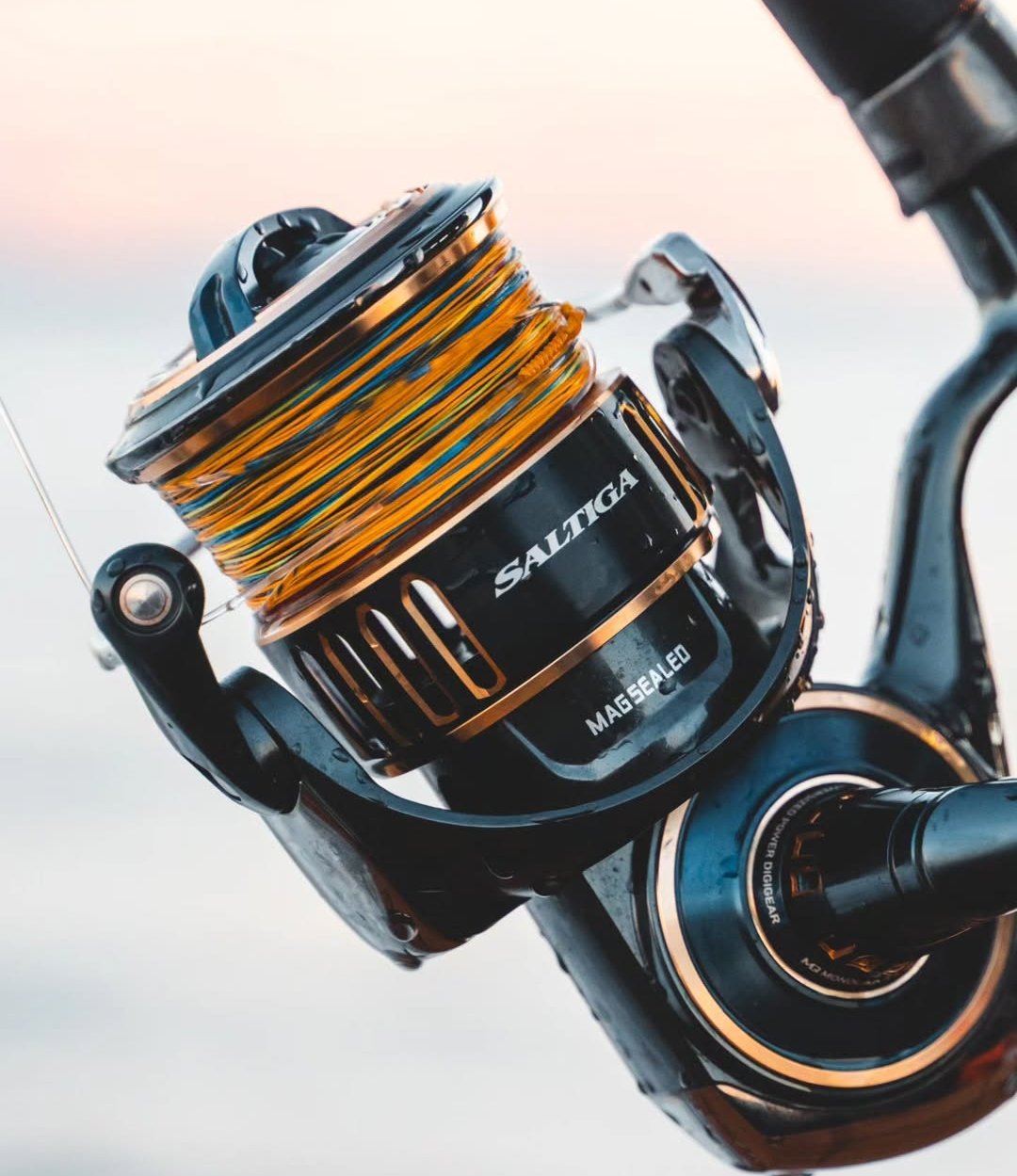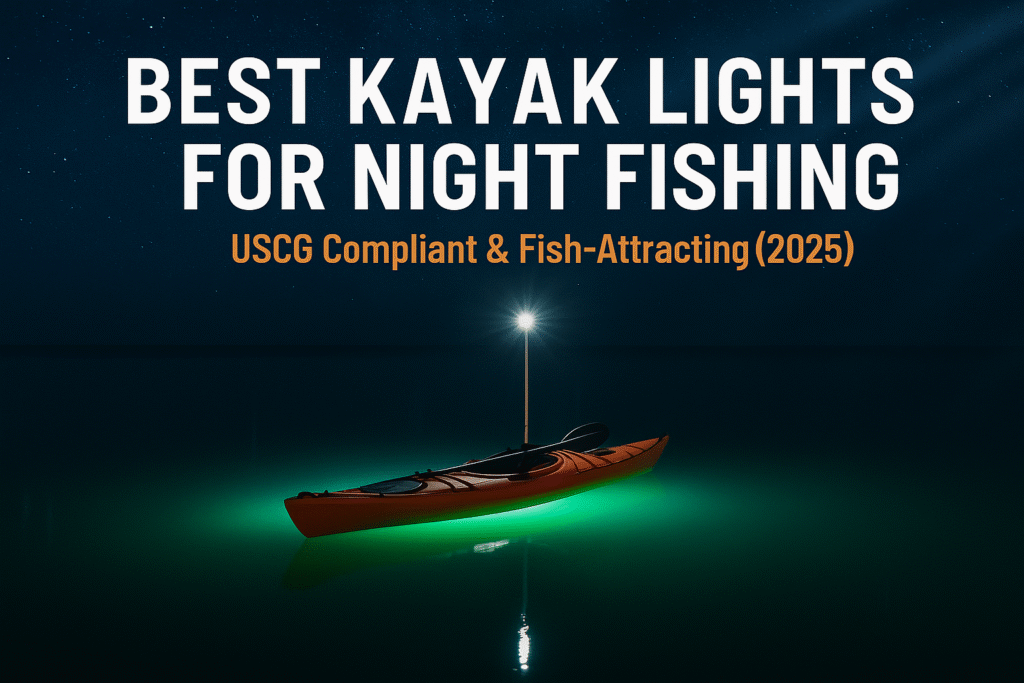
Picture this: You’re gliding silently across glassy water under a star-studded sky, your kayak cutting through the darkness as baitfish scatter beneath your hull, their scales catching the glow of your underwater lights. Night fishing from a kayak offers incredible opportunities, but without proper lighting, you’re risking both your safety and your legal compliance—not to mention missing the fish that lights can attract.
I learned this lesson the hard way during my first nighttime kayak fishing expedition. Armed with nothing but a headlight and misplaced confidence, I nearly collided with a powerboat that couldn’t see me until the last second. That heart-stopping moment taught me that proper kayak lighting isn’t just about following regulations—it’s about coming home safely while maximizing your fishing success.
The challenge for kayak anglers is finding lighting solutions that satisfy both U.S. Coast Guard requirements and effectively attract fish. You need lights that make you visible to other boaters from every angle while also drawing in the species you’re targeting. Add in considerations like battery life, mounting options, and weather resistance, and selecting the right lighting system becomes surprisingly complex.
In this comprehensive guide, I’ll walk you through everything you need to know about Best kayak lights for night fishing. We’ll cover USCG legal requirements, review the best lighting systems available in 2025, explore fish-attracting technologies, and provide practical installation tips. Whether you’re upgrading from basic safety lights or building a complete nighttime fishing rig, you’ll find the information you need to fish safely and successfully after dark.
🔑 Key Takeaways
- Legal compliance is non-negotiable: The minimum USCG requirement is a white light visible from 360 degrees, displayed in time to prevent collision
- Dual-purpose lighting maximizes effectiveness: The best systems combine navigation safety with fish-attracting capabilities
- Quality matters for reliability: Investing in marine-grade, weather-resistant lights ensures consistent performance when you need it most
- Installation flexibility is crucial: Choose mounting systems that allow quick adjustments and easy removal for security
- Battery management determines fishing time: Plan your power needs based on all-night fishing sessions, not just short trips
USCG Legal Requirements for Kayak Night Fishing
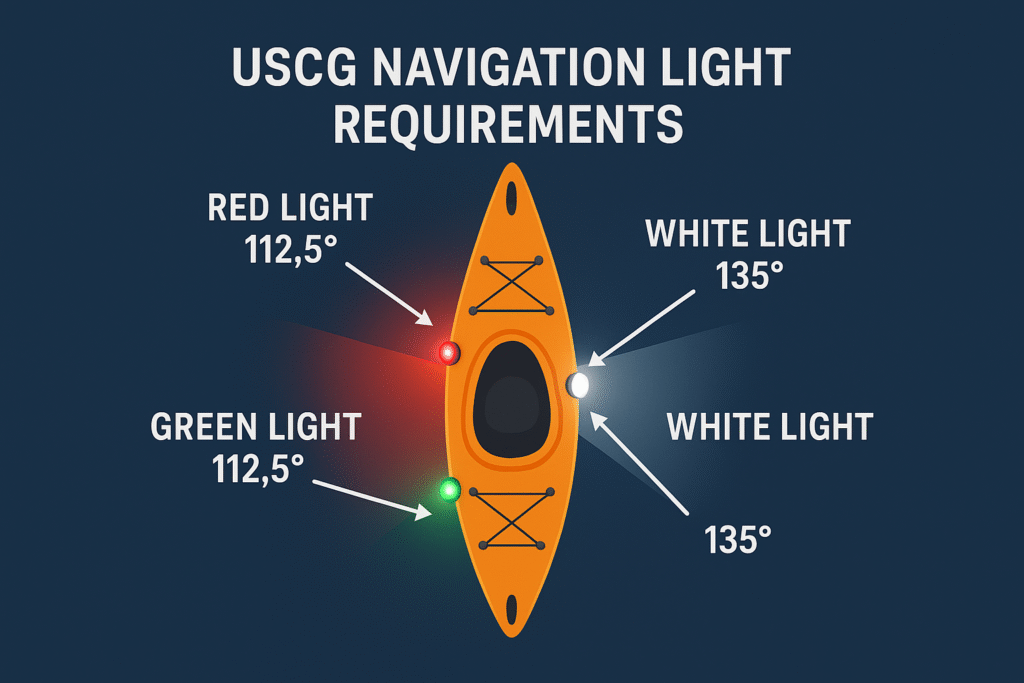
Understanding and following U.S. Coast Guard regulations isn’t just about avoiding fines—it’s about ensuring every angler makes it home safely. The rules might seem complex at first, but they’re designed with decades of maritime safety experience behind them.
Minimum Legal Requirements for Paddle Craft
The minimum requirement for kayaks and canoes (whether paddling or adrift) conforms with U.S. Coast Guard Rules for a “vessel under oars” requiring “an electric torch or lighted lantern showing a white light which shall be exhibited in sufficient time to prevent collision.” This seemingly simple requirement actually contains several important elements:
White Light Visibility Requirements:
- Must be visible from 360 degrees (all-around visibility)
- Minimum visibility distance of 2 miles on a clear night
- Must be displayed “in sufficient time to prevent collision”—meaning before another vessel gets close enough to create danger
The phrase “sufficient time” is deliberately vague because it depends on conditions. On a calm lake with minimal boat traffic, you might only need to display your light when you hear an approaching motor. In busy coastal waters or areas with fast-moving vessels, keeping your light on continuously is the safer choice.
State vs. Federal Regulations:
While federal requirements set the baseline, many states have additional rules:
- Florida requires a 360-degree white light displayed at all times between sunset and sunrise
- California mandates that the light be electric (no oil lanterns)
- Texas requires the light to be visible from at least 2 miles away
- Some states require additional safety equipment like whistles or horns
Always check your local regulations before launching. What’s legal on one side of a state line might earn you a citation on the other.
Navigation Light Standards and Specifications
For kayak anglers wanting enhanced visibility and professional-grade safety, proper navigation lights go beyond minimum requirements. The Attwood Water-Resistant Deck Mount LED Light exemplifies a complete system, featuring both a white LED stern light and red/green bow lights for additional visibility.
Color Requirements and Their Meanings:
- 🔴 Red light: Port (left) side, visible from dead ahead to 112.5 degrees
- 🟢 Green light: Starboard (right) side, visible from dead ahead to 112.5 degrees
- ⚪ White light: Stern (rear), visible from 135 degrees on each side
These colors communicate your direction of travel to other boaters, helping them determine right-of-way and avoid collisions. While not required for kayaks, using proper navigation lights significantly increases your safety profile.
Mounting Requirements:
- Lights should be mounted as high as practical without compromising stability
- Bow lights must be visible from directly ahead
- Stern lights need clear visibility from behind
- Avoid mounting positions that create glare in your eyes
Coastal vs. Inland Waterway Requirements
Different water types often have different regulations and practical considerations:
Inland Waters:
- Generally follow basic USCG requirements
- Local ordinances may add restrictions
- Lower risk of large vessel traffic
- Calmer conditions typically allow for simpler lighting
Coastal Waters:
- May require additional safety equipment (flares, VHF radio)
- Higher visibility standards due to larger vessels
- Consider strobe lights for emergency signaling
- Weather conditions demand more robust equipment
Enforcement and Penalties:
- First offense fines typically range from $100-$500
- Repeat violations can result in higher fines and equipment confiscation
- Coast Guard boardings are more common in coastal areas
- Local marine patrol enforcement varies widely
Remember, these regulations exist because darkness on the water is unforgiving. I’ve seen too many close calls that could have been prevented with proper lighting.
Top 7 Best Kayak Lights for Night Fishing (2025 Reviews)
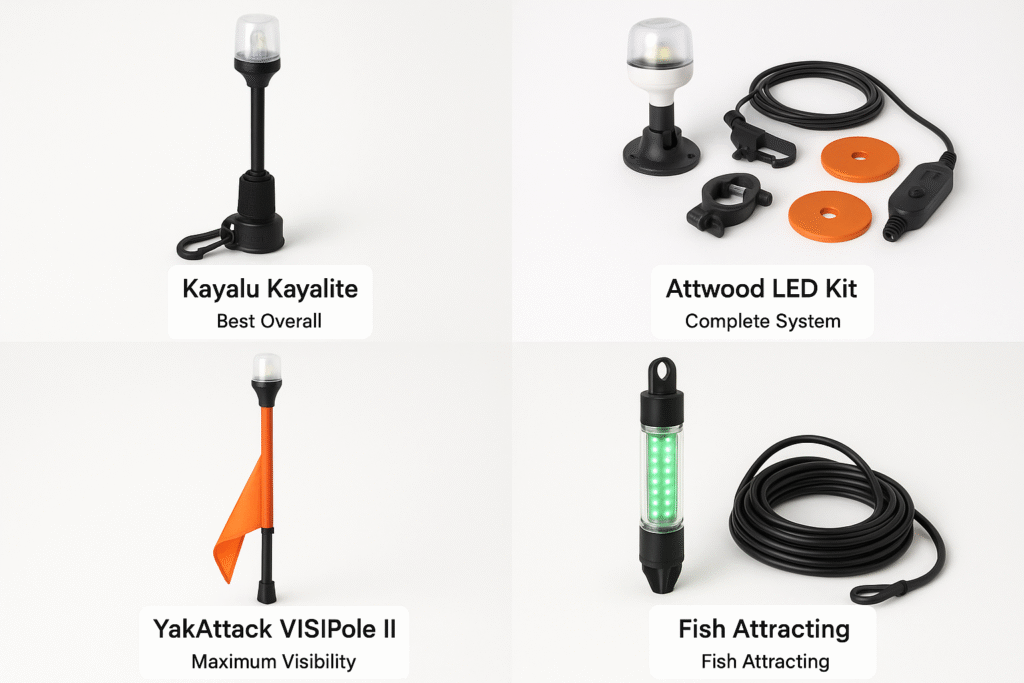
After testing dozens of lighting systems over countless night fishing trips, I’ve identified the top performers that balance safety compliance with fishing effectiveness. Each light on this list has proven itself in real-world conditions.
#1. Kayalu Kayalite Portable LED – Best Overall Compliance
The Kayalu Kayalite Portable Bright White LED Kayak Light stands out as the best overall choice for serious night anglers. This isn’t just another clip-on light—it’s a purpose-built solution designed by kayakers for kayakers.
USCG Compliance Analysis:
- ✅ Exceeds 2-mile visibility requirement with 3+ mile range
- ✅ True 360-degree visibility with no blind spots
- ✅ Meets all federal requirements for paddle craft
- ✅ Accepted by Coast Guard during inspections
Performance Metrics:
- Brightness: 100 lumens focused through precision optics
- Battery Life: 100+ hours on 3 AA batteries
- Visibility: Clear white light visible over 3 miles
- Weight: Just 4.5 ounces with batteries
The Kayalite’s secret is its elevated mounting position. Using a flexible 18-inch pole, it places the light above your head for unobstructed visibility. This design eliminates the shadows created by deck-mounted lights and ensures other boaters can see you from any angle.
Real-World Testing:
During a recent trip to Hilton Head Island, the Kayalite performed flawlessly through four consecutive nights of fishing. Even in choppy conditions with salt spray, the sealed housing kept moisture out and the light burning bright.
#2. Attwood Water-Resistant LED Kit – Best Complete System
For anglers wanting maximum visibility without complexity, the Attwood LED Navigation Light Kit provides everything you need in one package. This complete system transforms your kayak into a properly lit vessel that other boaters will respect.
What’s Included:
- Red/green bow light combination unit
- White stern light with adjustable base
- All mounting hardware and wiring
- Waterproof switch panel
- Detailed installation instructions
Installation Considerations:
Installing a permanent light system requires planning but pays dividends in reliability:
- Choose mounting locations that don’t interfere with paddling
- Run wiring through the hull or use surface-mount channels
- Install the switch panel within easy reach
- Use marine-grade sealant on all penetrations
The Attwood kit shines in its versatility. The lights can run on a small 12V battery pack all night, and the LED technology means you won’t drain your power supply during extended trips.
#3. YakAttack VISIPole II – Best Visibility Enhancement
Many anglers start with basic lights only to realize they need more visibility. As one user noted, “I have a YakAttack light but it’s really not that bright.” The VISIPole II addresses this concern with significant improvements over earlier models.
Key Improvements:
- 40% brighter than the original VISIPole
- Reinforced pole construction resists bending
- Quick-release base for easy storage
- Compatible with RAM mounting systems
Visibility Advantages:
The pole-mounted design elevates your light 3 feet above the deck, dramatically increasing visibility range. This height advantage means your light clears waves and chop that might obscure deck-mounted options.
Practical Benefits:
- Collapses quickly for launching and landing
- Stores inside most kayak hatches
- Doubles as a flag mount during daytime
- Works with existing YakAttack track systems
#4. GearLight LED Safety Lights – Best Budget Option
Don’t let the low price fool you—GearLight LED safety lights pack serious performance into an affordable package. As their marketing claims, “They may be small, but their lights shine brighter than diamonds in the sky.”
Value Proposition:
- Price: Under $25 for a 2-pack
- Brightness: 200 lumens per light
- Battery Life: 12 hours continuous, 60 hours flashing
- Durability: IPX5 water resistance rating
Versatility Features:
These lights excel in their multiple mounting options:
- Strong magnetic base for metal surfaces
- Sturdy clip for PFDs or deck rigging
- Lanyard hole for tethering
- Velcro strap compatibility
I keep a pair of GearLights as backup lighting on every trip. Their reliability and versatility make them perfect for anglers building their night fishing setup on a budget.
#5. Yak Lights LED System – Best Made-in-USA Option
Born from necessity by passionate kayak fishermen, Yak Lights identified a gap in the market for quality lighting at competitive prices. Their dedication to the kayaking community shows in every design detail.
Angler-Designed Features:
- Low-profile mounting to reduce wind resistance
- Glare shields to protect night vision
- Quick-disconnect wiring for security
- Modular system for customization
Quality Construction:
- Marine-grade aluminum housing
- Potted electronics for waterproofing
- Stainless steel hardware throughout
- UV-resistant plastics and coatings
Customer Support Excellence:
- Lifetime warranty on LED components
- Phone support from actual kayak anglers
- Replacement parts readily available
- Active online community for troubleshooting
#6. Underwater Fish Attracting Lights – Best Fishing Performance
While navigation lights keep you safe, underwater LED fishing lights actively improve your catch rate. These submersible systems create an underwater glow that attracts baitfish, which in turn brings in predators.
Technology Overview:
- High-output green or blue LEDs
- Submersible to 50+ feet
- 360-degree light dispersion
- 15,000+ hour LED lifespan
Species-Specific Effectiveness:
- Green lights: Best for freshwater species, especially crappie and bass
- Blue lights: Excellent for saltwater, particularly snook and tarpon
- White lights: Good all-around choice but less effective than colored options
Power Considerations:
Underwater lights consume more power than navigation lights:
- Typical draw: 1-3 amps per light
- Recommended battery: 12V deep cycle, 35Ah minimum
- Runtime: 8-12 hours depending on brightness
- Consider dual battery setup for all-night trips
#7. Solar-Powered Navigation Lights – Best Eco-Friendly Option
For environmentally conscious anglers, solar-powered navigation lights offer sustainable illumination without the hassle of battery management. Modern solar technology has finally reached the reliability level needed for marine use.
Solar Charging Capabilities:
- Full charge in 6-8 hours of direct sunlight
- Cloudy day charging still provides 4-6 hours runtime
- Built-in battery stores 3 nights worth of power
- Automatic dusk-to-dawn operation available
Weather Resistance Features:
- IP68 waterproof rating (submersible)
- Impact-resistant polycarbonate lenses
- Corrosion-proof mounting hardware
- Operating temperature: -4°F to 140°F
Long-Term Value:
While the initial investment is higher, solar lights pay for themselves:
- No battery replacement costs
- Zero operating expenses
- 5+ year typical lifespan
- Reduced environmental impact
Kayak Lights Comparison Table
| Product | Price Range | Battery Life | Visibility Range | Installation | Rating | Best For |
|---|---|---|---|---|---|---|
| Kayalu Kayalite Portable LED | $$ | 100+ hours | 3 miles | Easy (Portable) | Overall Best | |
| Attwood Water-Resistant LED Kit | $$$ | 50+ hours | 2 miles | Complex (Permanent) | Permanent Setup | |
| YakAttack VISIPole II | $$ | 60+ hours | 3+ miles | Easy (Portable) | Max Visibility | |
| GearLight LED Safety Lights | $ | 12 hours | 1 mile | Very Easy | Budget Choice | |
| Yak Lights LED System | $$$$ | 80+ hours | 2.5 miles | Moderate | Premium Quality | |
| Underwater Fish Attracting Lights | $$$ | 8-12 hours | N/A (Underwater) | Easy (Submersible) | Fish Attraction | |
| Solar-Powered Navigation Lights | $$$$ | 3 nights stored | 2 miles | Easy (Solar) | Eco-Friendly |
Kayak Light Selection Timeline
Kayak Light Recommendation Calculator
Fish-Attracting Lights vs. Navigation Lights

Understanding the distinction between safety lighting and fishing lights is crucial for night fishing success. While both involve illumination, their purposes and optimal configurations differ significantly.
How Lights Affect Fish Behavior
The science behind light attraction, known as phototaxis, explains why certain fish species are drawn to artificial illumination. This biological response varies dramatically between species and environmental conditions.
Phototaxis Principles:
- Positive phototaxis: Fish attracted to light (baitfish, squid)
- Negative phototaxis: Fish that avoid light (some bottom dwellers)
- Indirect attraction: Predators following baitfish to lights
- Temporal variations: Responses change with moon phases
Species-Specific Responses:
🐟 Attracted Species:
- Shrimp and small crustaceans (primary attractant)
- Baitfish: minnows, shad, sardines
- Squid (extremely light-positive)
- Crappie and white perch
- Snook, tarpon, and striped bass (following bait)
🚫 Light-Shy Species:
- Large catfish (prefer darkness)
- Some bass during full moon
- Pressured fish in heavily fished areas
Optimal Light Placement:
- Underwater placement: 2-4 feet below surface for maximum baitfish attraction
- Angle consideration: 45-degree angle creates larger illuminated area
- Multiple lights: Create a “light field” rather than single point source
- Distance from kayak: 3-5 feet prevents spooking fish under the boat
Dual-Purpose Lighting Systems
Modern technology allows lights that serve both navigation and fishing functions, maximizing value and minimizing equipment.
Switching Mechanisms:
- Toggle between white (navigation) and green/blue (fishing)
- Dimmer controls for adjusting attraction intensity
- Timer functions for automated switching
- Remote control options for hands-free operation
Power Management Strategies:
Running dual-purpose systems requires careful planning:
- Calculate total amp draw for all-night operation
- Use separate batteries for navigation vs. fishing lights
- Install voltage monitors to prevent dead batteries
- Consider backup power sources
Cost-Effectiveness Analysis:
- Single dual-purpose light: $150-300
- Separate navigation + fishing lights: $200-400
- Power savings from integrated control: 20-30%
- Reduced installation complexity saves time and money
Underwater vs. Above-Water Lighting
The placement of your fishing lights dramatically affects their effectiveness. Each approach has distinct advantages depending on your target species and conditions.
Underwater Light Advantages:
- ✅ Direct baitfish attraction through illuminated water column
- ✅ Less glare and vision interference for the angler
- ✅ Creates natural feeding environment
- ✅ More effective in clear water
Above-Water Benefits:
- ✅ Easier to deploy and adjust
- ✅ No risk of snagging or loss
- ✅ Can double as work lights for rigging
- ✅ Better for murky water conditions
Combination Strategies:
The most successful night anglers often use both:
- Underwater lights to build the food chain
- Subtle above-water lighting for bait preparation
- Adjustable positioning based on conditions
- Color combinations for maximum attraction
Installation and Mounting Solutions
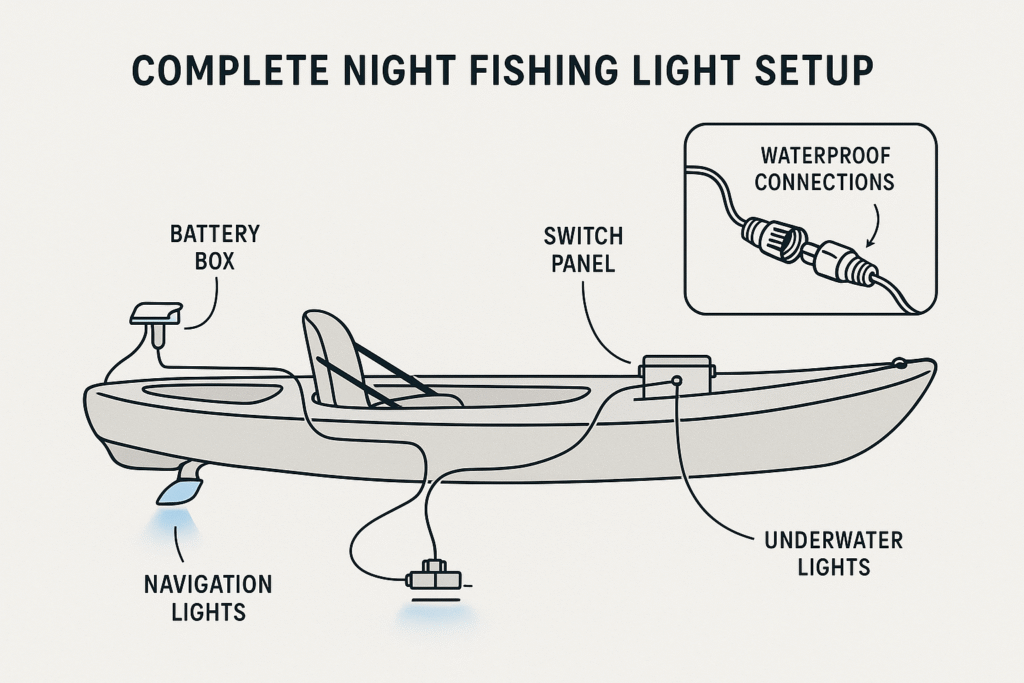
Proper installation transforms good lights into great fishing tools. The difference between a professionally mounted system and a hastily attached light can mean the difference between consistent success and frustrating failures.
Permanent vs. Portable Mounting Options
Your fishing style and kayak type determine the best mounting approach. Each method offers distinct advantages for different situations.
Permanent Mounting Benefits:
- Rock-solid stability in rough conditions
- Clean wire routing through hull
- Theft deterrent when properly installed
- Professional appearance
Installation Process:
- Planning: Map wire routes and switch locations
- Drilling: Use step bits for clean holes
- Sealing: Marine sealant on all penetrations
- Testing: Verify operation before final assembly
Portable Mounting Advantages:
- Transfer between multiple kayaks
- Easy removal for security
- No hull modifications required
- Flexibility for different fishing styles
Popular Portable Systems:
- RAM ball mounts: Infinite adjustability, tool-free operation
- YakAttack tracks: Slide anywhere along track length
- Magnetic mounts: Quick deployment on metal surfaces
- Suction cups: Temporary mounting for rentals
Power Management and Battery Solutions
Night Fishing Light & Battery Calculator
Your Night Fishing Light Requirements
Reliable power determines whether you fish all night or paddle home early. Understanding your power needs prevents disappointing trips.
Calculating Power Requirements:
| Light Type | Current Draw | 8-Hour Runtime Needs |
|---|---|---|
| Navigation LED | 0.5A | 4Ah |
| Underwater fishing light | 2.5A | 20Ah |
| Deck work light | 1A | 8Ah |
| Total System | 4A | 32Ah |
Battery Selection Guide:
- AGM batteries: Best for reliability and deep discharge
- Lithium options: Lighter weight but higher cost
- Battery boxes: Waterproof protection essential
- Dual battery setups: Separate navigation from fishing power
Charging Solutions:
- Solar panels for multi-day trips
- Portable power stations for quick charging
- DC-DC chargers from vehicle while traveling
- Smart chargers to maximize battery life
Wiring and Weatherproofing
Marine environments are brutal on electrical systems. Proper installation prevents corrosion and ensures years of reliable operation.
Wire Selection:
- Marine-grade tinned copper only
- Minimum 16 AWG for most applications
- Color coding for easy troubleshooting
- Extra length for stress relief loops
Connection Best Practices:
- Heat-shrink terminals with adhesive lining
- Dielectric grease on all connections
- Drip loops to prevent water ingress
- Regular inspection and maintenance
Switch Panel Considerations:
- Waterproof rating IP65 minimum
- Backlit switches for night visibility
- Circuit breakers vs. fuses
- Accessible location from seated position
Safety Protocols for Night Fishing
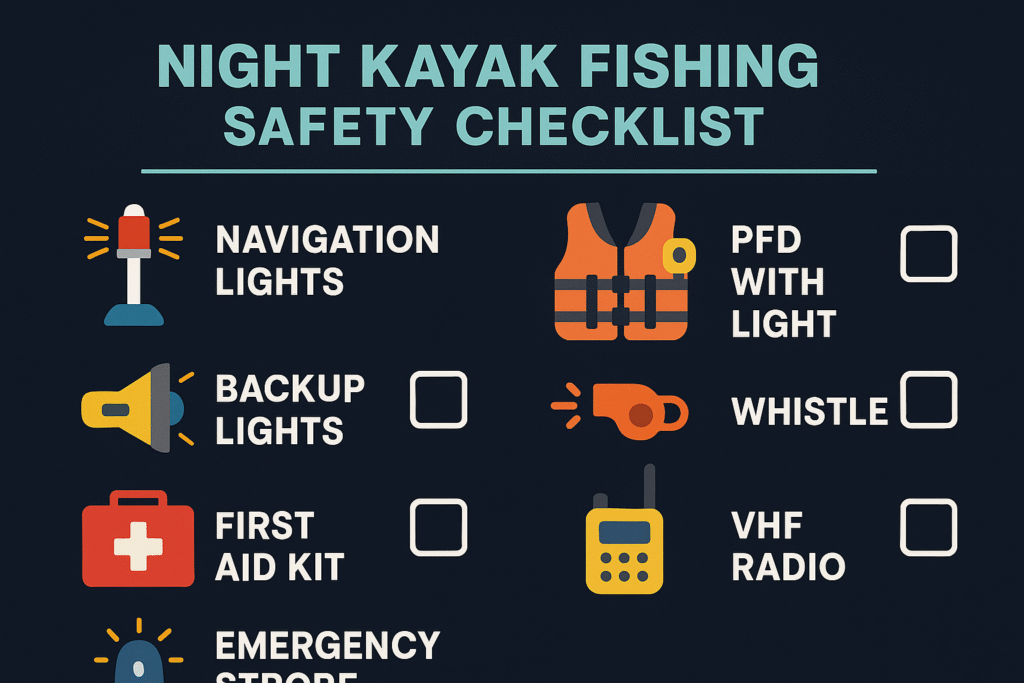
Darkness amplifies every risk on the water. Comprehensive safety planning goes beyond lights to ensure successful trips.
Pre-Launch Safety Checklist
Developing a consistent routine prevents oversights that could prove dangerous hours later.
Essential Checklist Items:
- [ ] Test all lights with fresh batteries
- [ ] Verify backup light functionality
- [ ] Check weather forecast and moon phase
- [ ] File float plan with someone on shore
- [ ] Inspect PFD light attachment
- [ ] Test communication devices
- [ ] Review emergency procedures
Equipment Verification:
Beyond basic functionality, ensure your gear can handle worst-case scenarios:
- Backup batteries in waterproof container
- Chemical light sticks for emergencies
- Whistle attached to PFD
- Reflective tape on paddle blades
- First aid kit with flashlight
On-Water Safety Practices
Once launched, disciplined practices keep you safe throughout the night.
Light Operation Protocol:
- Continuous display in high-traffic areas
- 360-degree checks before moving
- Extra vigilance during low visibility
- Conservative decisions when uncertain
Collision Avoidance Techniques:
- Listen for engines before they’re visible
- Use sound signals in fog
- Stay clear of shipping channels
- Assume you’re invisible to power boats
Group Coordination:
When fishing with others:
- Establish light signals for communication
- Maintain visual contact intervals
- Designate lead and sweep positions
- Use VHF radio for coordination
Emergency Equipment and Backup Plans
Hope for the best but prepare for the worst. Night emergencies require immediate, decisive action.
Critical Emergency Gear:
- 🚨 Strobe light: Visible for miles, essential for rescue
- 📡 VHF radio: Channel 16 monitored 24/7
- 🎆 Flares: Last resort signaling devices
- 📱 Cell phone: In waterproof case with full charge
Emergency Action Plans:
- Capsize: Activate strobe, stay with kayak
- Collision: Check for injuries, signal for help
- Equipment failure: Use backups, consider returning
- Medical emergency: Call for help immediately
Recovery Considerations:
- Practice re-entry in daylight first
- Know your limits in cold water
- Understand hypothermia symptoms
- Have extraction plan for injured anglers
Seasonal and Regional Considerations
Night fishing conditions vary dramatically with seasons and locations. Adapting your lighting strategy ensures year-round success.
Cold Weather Performance
Winter night fishing presents unique challenges that test equipment and resolve. I’ve learned these lessons through chattering teeth and numb fingers.
Battery Performance Issues:
- Capacity drops 20-50% in freezing temperatures
- Chemical reactions slow, reducing output
- Lithium batteries perform better than lead-acid
- Keep spare batteries warm inside clothing
LED Efficiency Benefits:
- LEDs maintain brightness in cold
- No warm-up period like incandescent
- Lower power draw extends runtime
- Instant operation in any temperature
Condensation Management:
- Seal entry points before temperature drops
- Use desiccant packs in battery boxes
- Apply anti-fog treatments to lenses
- Allow equipment to acclimate before use
Winter-Specific Recommendations:
- Upgrade to lithium batteries for cold performance
- Add chemical heat packs to battery boxes
- Use sealed, submersible-rated lights
- Carry extra backup lighting
Saltwater vs. Freshwater Applications
The corrosive nature of saltwater demands different equipment and maintenance approaches than freshwater fishing.
Corrosion Resistance Requirements:
| Component | Freshwater | Saltwater |
|---|---|---|
| Housing | Aluminum OK | Stainless/Plastic only |
| Hardware | Zinc plated | 316 Stainless |
| Connections | Standard | Sealed/Potted |
| Maintenance | Monthly | After each use |
Species-Specific Strategies:
- Saltwater: Blue/green lights for snook, tarpon
- Freshwater: White/green for crappie, bass
- Brackish: Dual-color systems for versatility
- Deep water: High-intensity for penetration
Maintenance Protocols:
- Rinse all equipment with freshwater
- Dry completely before storage
- Apply corrosion inhibitor monthly
- Replace sacrificial anodes annually
Regional Regulation Variations
Navigation requirements change dramatically between regions. What’s legal in Arkansas waters might not pass muster on the coast.
State-Specific Examples:
- Florida: Requires lights sunset to sunrise, strictly enforced
- California: Electric lights only, no flames
- Great Lakes: Follow international rules
- Texas: Additional requirements for coastal waters
Permit Requirements:
Some areas require special permits for night fishing:
- Marine sanctuary restrictions
- Military water boundaries
- Commercial fishing zone limitations
- Seasonal closures for spawning
Local Knowledge:
- Check with bait shops for local requirements
- Join regional kayak fishing forums
- Contact marine patrol for clarification
- Attend local kayak fishing club meetings
Cost Analysis and Value Assessment
Understanding the true cost of night fishing lighting helps make informed decisions that balance safety, effectiveness, and budget.
Initial Setup Costs
Building a complete night fishing lighting system requires investment, but options exist for every budget level.
Basic Compliance Setup ($30-75):
- Single white LED light: $25-40
- Mounting hardware: $5-15
- Batteries: $10-20
- Total: Meets legal requirements minimally
Mid-Range Fishing System ($75-200):
- Navigation lights: $50-75
- Basic underwater light: $75-100
- Battery and box: $25-50
- Total: Good balance of safety and fishing
Premium Integrated System ($200-500+):
- Complete navigation suite: $150-200
- Multiple underwater lights: $200-300
- Lithium battery system: $150-200
- Professional installation: $100-150
- Total: Maximum effectiveness and reliability
Operating Costs and Maintenance
The purchase price is just the beginning. Understanding ongoing costs prevents budget surprises.
Annual Operating Expenses:
| Item | Basic | Mid-Range | Premium |
|---|---|---|---|
| Batteries | $20-30 | $40-60 | $0-20 |
| Replacement bulbs | $0 | $0 | $0 |
| Cleaning supplies | $10 | $15 | $20 |
| Repairs | $0-20 | $20-40 | $30-50 |
| Annual Total | $30-60 | $75-115 | $50-90 |
Maintenance Requirements:
- Weekly: Rinse and dry after use
- Monthly: Check connections and battery terminals
- Seasonally: Deep clean and inspect
- Annually: Replace worn components
Return on Investment
Quality lighting pays dividends beyond monetary calculations.
Safety Value:
- Accident prevention: Priceless
- Insurance considerations: May reduce premiums
- Peace of mind: Enables confident night fishing
- Legal compliance: Avoids costly citations
Fishing Success Improvements:
- Increased catch rates: 30-50% for light-attracted species
- Extended fishing hours: 6-8 additional hours per trip
- Access to night-feeding fish: Exclusive opportunities
- Year-round fishing: Not limited to daylight
Equipment Longevity:
- Quality lights last 5-10 years
- Protect kayak from collision damage
- Enable safer launches/landings
- Reduce wear on other equipment
Resale Impact:
A well-equipped fishing kayak with quality lighting commands premium resale prices. Buyers value:
- Professional installation
- Complete documentation
- Proven reliability
- Transferable warranties
Frequently Asked Questions: Kayak Night Fishing Lights
Do I need special lights to fish at night from a kayak?
Yes, you absolutely need proper lighting for legal and safety reasons. At minimum, federal law requires a white light visible from all directions to prevent collisions. However, for effective night fishing, you’ll want additional lights:
- Legal requirement: 360-degree white light
- Safety enhancement: Navigation lights (red/green/white)
- Fishing effectiveness: Underwater attractant lights
- Convenience: Deck work lights for rigging
The investment in proper lighting pays for itself through safer trips and better catches. Don’t risk your safety or a costly citation by skimping on lights.
What color lights work best for attracting fish?
Color selection significantly impacts fishing success, with different wavelengths attracting different species:
🟢 Green Lights (520-560nm):
- Best overall for freshwater species
- Excellent baitfish attraction
- Good penetration in murky water
- Proven for crappie, bass, and catfish
🔵 Blue Lights (450-490nm):
- Superior for clear saltwater
- Attracts squid and small baitfish
- Preferred by snook and tarpon
- Less effective in stained water
⚪ White Lights:
- Good all-around choice
- Less specialized but versatile
- Better for human vision
- Can spook pressured fish
The key is matching light color to your water conditions and target species. Many successful anglers use multiple colors simultaneously.
How long do kayak fishing lights typically last?
Modern LED lights offer exceptional longevity compared to older technologies:
LED Lifespan:
- Quality LEDs: 50,000+ hours
- Typical use (100 nights/year × 8 hours): 10+ years
- No filaments to break
- Gradual dimming vs. sudden failure
Battery Runtime:
- Navigation lights: 50-100 hours per battery set
- Underwater lights: 8-12 hours on 35Ah battery
- Solar lights: Indefinite with proper charging
- Rechargeable systems: 500+ cycles
Factors Affecting Longevity:
- Quality of initial purchase
- Proper maintenance and storage
- Protection from impacts
- Regular cleaning and inspection
Can I use regular flashlights for kayak navigation?
While a flashlight technically meets minimum USCG requirements, it’s not ideal for several reasons:
Legal Issues:
- Must be displayed “in time to prevent collision”
- Requires constant hand-holding
- Difficult to maintain 360-degree visibility
- May not meet brightness requirements
Practical Problems:
- Occupies a hand needed for paddling
- Creates blind spots
- Battery life typically insufficient
- Not designed for marine environment
Better Alternatives:
- Clip-on LED lights ($20-30)
- Magnetic safety lights ($25-40)
- Proper navigation lights ($50+)
- Headlamp as backup only
Invest in purpose-built marine lighting for reliability and safety.
Are there different requirements for saltwater vs. freshwater?
While federal navigation light requirements remain consistent, practical considerations differ significantly:
Equipment Differences:
- Saltwater: Requires corrosion-resistant materials
- Freshwater: Standard materials usually sufficient
- Maintenance: Saltwater demands immediate rinsing
- Durability: Salt environment shortens equipment life
Regulatory Variations:
- State-specific rules may differ
- Coastal waters often have stricter enforcement
- Some areas require additional safety equipment
- Local ordinances may add requirements
Fishing Light Considerations:
- Blue lights work better in clear saltwater
- Green excels in freshwater and stained water
- Brightness needs vary with water clarity
- Species preferences differ by environment
Always check local regulations and choose equipment rated for your environment.
Conclusion
Night fishing from a kayak opens up a world of opportunities that daylight anglers miss. The serene beauty of gliding across moonlit water, the excitement of fish drawn to your lights, and the satisfaction of mastering a challenging technique make every properly equipped trip memorable. But as we’ve explored throughout this guide, success starts with the right lighting setup.
Remember that compliance with USCG regulations isn’t just about avoiding fines—it’s about ensuring you return safely from every adventure. The minimum requirement of a white light visible from all directions forms your safety foundation, but the best night fishing experiences come from comprehensive lighting systems that enhance both visibility and fishing effectiveness.
Whether you choose the reliable Kayalu Kayalite for its superior visibility, invest in a complete Attwood navigation system, or build a custom setup with underwater attractant lights, prioritize quality and reliability. Your lights are your lifeline after dark, and cutting corners on this essential equipment simply isn’t worth the risk.
Your Next Steps:
- Assess your current setup against USCG requirements and identify any gaps
- Determine your budget and prioritize safety compliance first, fishing lights second
- Choose appropriate mounting solutions for your specific kayak model
- Practice with your lights during daylight before your first night trip
- Start with familiar waters and gradually expand your night fishing range
The investment in proper lighting pays dividends through safer trips, better catches, and the confidence to explore new waters after dark. As someone who’s spent countless nights on the water, I can assure you that the right lights transform night fishing from a risky proposition into one of kayak angling’s most rewarding experiences.
Stay safe, stay legal, and let your lights lead you to incredible night fishing adventures. The fish are waiting, and now you have the knowledge to find them safely in the darkness.

